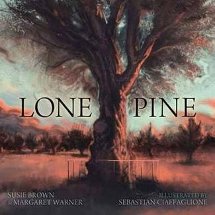Lone Pine by Susie Brown and Margaret Warner

Ill. by Sebastian Ciaffaglione. Little Hare, 2012. ISBN 978 1 921541
34 6.
Warmly recommended. Picture book, ANZAC. A story not well known
about the Lone Pine Battle at Gallipoli during World War One, is
told through the tale of the pine tree which stands in the gardens
at the War Memorial in Canberra.
One young man, searching for his brother's body after the Battle of
Lone Pine, came across a branch with a pine cone still attached.
Sending this back to his mother in Australia, she raised three small
trees from the cone, two doing well, and one withering and dying,
just like her three sons. In 1930, one of the two surviving trees
was put on the train and sent to Canberra where the new War Memorial
was being built, and the other planted at the Inverell Park as a
memorial to her dead son. In 1934 the Duke of Gloucester planted the
tree in the gardens at the War Memorial, and there it stands today
as a testament to the courage of the Australian troops at the Battle
of Lone Pine.
This moving story will be well used at ANZAC Day in schools as it
reminds us all of the sacrifice made by the families of Australia,
in sending heir sons to fight a losing battle at Gallipoli. The
bareness of the battlefield, stripped of its trees for shelter, is
recalled when veterans took back trees grown from the seeds of the
Lone Pine at Canberra to Turkey to remind us of the area so
devastated by war nearly 100 years ago. The evocative illustrations
concentrate the eye onto one scene on each double page spread. They
are uncluttered, at times almost bare, tugging an emotional response
from the reader, and telling a story through the images presented.
At the end of the book is an outline of the family involved, giving
another layer to the story, and a brief summary of what happened to
the pine trees that were grown from the boy's seeds. For
those wanting to read a story on ANZAC Day which is a little
different from the norm, then this will fit the bill perfectly. It
is not well know, it portrays all that is significant about ANZAC
Day to Australians, and tells how families were affected by the war.
That it is true adds another layer of meaning and discussion with
classes. For those lucky enough to live in Canberra, a trip to the
amazing War Memorial will be that much richer.
Fran Knight